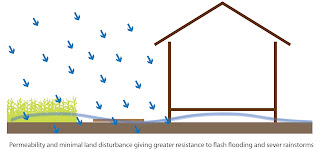Our Woodfordia has developed a resilience to combat the
unsustainable ways of the world and the devastating effects they had. As
climate change evolved it caused sea level rises and huge changes in weather
patterns. Storms became more harsh with flash flooding seen regularly through
SEQ, followed by droughts. By 2050 a 1m sea level rise had displaced over 60
million people.
These sea level rises caused millions of people to be
displaced from their homes and Australia took them in as we have the space. In
order to continue to survive communities had to learn to sustain themselves.
Woodford trialled a new program of sustainable living, supporting themselves
with only the resources near to them.
Models for living were developed, using permeable
structures, providing all resources from their surrounding areas and using the
land strategically. The community at Woodford was a success, and began to student
new communities. The site became an educational place, with only few permanent
residents and both climate refugees and Australian residents participating to
learn how to live sustainably as it became vital to populate Australia's
regional areas.
Their lives involve putting their skills to work, rotating
through different areas from planning to building to agriculture to energy. The
participants need to understand every aspect of sustainably living by the end
of their period at Woodfordia. New communities are only as large as
sustainable, if the area they're in can't feasibly support a large population
there will be a cap.
The buildings are adaptable to accommodate for changing
needs and function to serve the community as well as possible with the smallest
possible impact on the site. The buildings have strength and protection for the
greatest possibility to withstand storms. As well as this the permeable nature
of paths and buildings helps to mitigate the flash flooding common in freak
storms.























